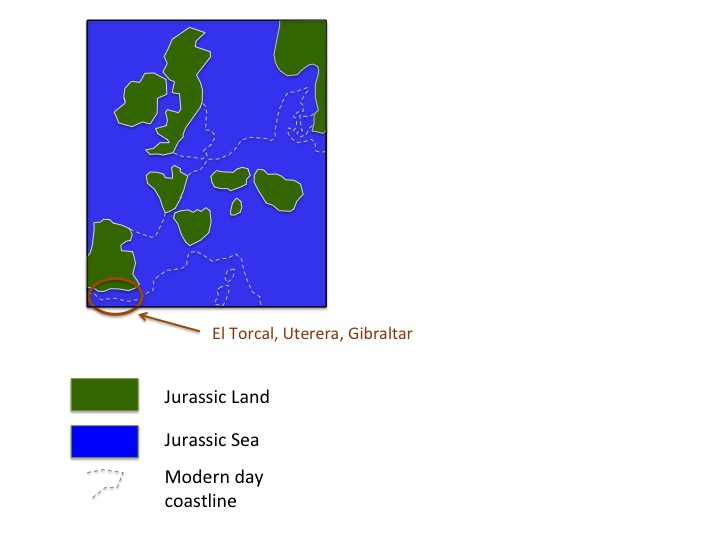Individual places and topics of interest
El Torcal, Rock of Gibraltar, Utrera canyon - examples of Jurassic limestone
During the Jurassic, and especially the Early Jurassic, extensive warm shallow seas blanketed much of modern-day Europe, including southern Spain (Chapter 2). Carbonate platform environments developed, somewhat like the modern-day Bahamas, resulting in thick carbonate rich sediments that were subsequently buried and lithified into limestone rock. Southern Spain exhibits many examples of these limestones which were uplifted during the collision between Africa and Eurasia (Chapter 3) and are now typically exposed as prominent topographic features due to their relative hardness compared to surrounding rocks. They also show common evidence of karstification including caves.
Karstification: Limestone is composed primarily of the mineral calcium carbonate which is readily dissolved by acidic rainwater or acidic groundwater formed when water plus carbon dioxide from the atmosphere or from vegetation create carbonic acid:
H2O + CO2 => H2CO3 H2CO3 + CaCO3 => Ca(HCO3)2
water + carbon dioxide => carbonic acid carbonic acid + limestone => calcium bicarbonate dissolved in the groundwater
Karstification: Limestone is composed primarily of the mineral calcium carbonate which is readily dissolved by acidic rainwater or acidic groundwater formed when water plus carbon dioxide from the atmosphere or from vegetation create carbonic acid:
H2O + CO2 => H2CO3 H2CO3 + CaCO3 => Ca(HCO3)2
water + carbon dioxide => carbonic acid carbonic acid + limestone => calcium bicarbonate dissolved in the groundwater
|
Dissolving of the limestone initiates where the acidic waters run into and along natural depressions and fractures in the rock - a self reinforcing process which widens and deepens them over time. The eventual result of this 'dissolution' over the course of millions of years is a huge variety of possible forms and shapes that can get created, often resembling animals, buildings or people - a bit like 'rock topiary'. El Torcal park, south of Antequera, houses excellent examples of karst formations.
Another form of karst is a flat, incised surface of exposed limestone that resembles irregular paving stones. This is called limestone pavement and in Utrera guide leaflets it has been mistaken in places for sections of a man-made Roman road. The bulk of the peninsula of Gibraltar, and its imposing cliffs, are composed of Early Jurassic limestone. Here dissolution has created vast caverns and caves, some of which are open to visitors. The development of dramatic forms of stalactite and stalagmite in these caves is due to calcium bicarbonate coming back out of solution from seeping and dripping groundwater under the right temperature conditions, and re-depositing solid calcium carbonate. |




